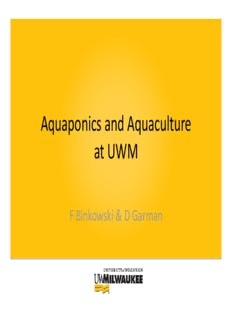
Aquaponics and Aquaculture at UWM PDF
Preview Aquaponics and Aquaculture at UWM
Aquaponics and Aquaculture at UWM FF BBiinnkkoowwsskkii && DD GGaarrmmaann Problems and Opportunities USA trade deficit in seafood is nniinnee bbiilllliioonn ddoollllaarrss ($9,000,000,000) annually. • Number 3 in impports – onlyy automobiles and oil are more. Global demand is expected to ddoubblle bby 22003300. Wild fish stocks are declining Pond aquaculture requires new technology CCoonnssuummppttiioonn • GGlloobbaall aavveerraaggee ffoorr ffiisshh ccoonnssuummppttiioonn iiss oovveerr 3300 pounds per capita. Fish consumption in the U.S. remains steady at 15.8 pounds per capita. • The average American consumed – 11.8 pounds of fresh and frozen finfish and shellfish, – 3.7 pounds of canned seafood, primarily canned tuna, and – 0.3 pounds of cured seafood, such as smoked salmon and ddrriieedd ccoodd. AAqquuaaccuullttuurree aass aann iinndduussttrryy AAqquuaaccuullttuurree iiss tthhee ffaasstteesstt growing food‐producing industry in the world • average annual growth rate of 8.7% per year • three times higher than terrestrial farm meat Aquaculture Research Institute, University of Idaho; M. Powell, Ph.D., Associate Professo PPoonndd AAqquuaaccuullttuurree IIssssuueess • LLooww iinntteennssiittyy • Risk of contamination • EEnnvviirroonnmmeennttaall ccoonnttrroollss • Low margins •• FFoooodd ssoouurrcceess • Food safety FDA issues •• WWiilldd eessccaappeess IImmppoorrttss Over 5.5 billion pounds of seaffoodd iimportts ((22001100)) – China, Thailand, Canada, IInnddoonneessiiaa,, VViieettnnaamm,, aanndd Ecuador (rank order by volume) – Thhe tradde ddefficit, allreaddy at 86%, continues to ggrow, due pprimarilyy to cost advantages in Asia. Fish species imports Two of the top ten seafood items consumed in America are freshwater fin‐fish: Tilapia (#4) and Pangasius or Vietnamese Catfish (#6). Paul Greenberg, Four Fish: The Future of the Last Wild Food (Penguin, USA, 2010) National Marine Fisheries Service, NOAA, US Dept of Commerce: Fishwatch U.S. Seafood Facts: hhttttpp::////wwwwww.nnmmffss.nnooaaaa.ggoovv//ffiisshhwwaattcchh//ttrraadd e_and_aquaculture.htm National Fisheries Institute, McLean, VA; 2010 list; http://www.aboutseafood.com/about/abo ut‐seafood Production Challenges • Major challenges in fin‐fish aquaculture (e.g. salmon, sea bass, tilapia, trout, etc.) are year round breeding stock, feed sources, conversion ratios, and disease management. • EEven whhen tthhese ellementts are successffulllly addressed, marketing and profitability strategies can uullttiimmaatteellyy bbee aass iimmppoorrttaanntt. • Increasing pressures – fish food; pollution controls; cclliimmaattee vvaarriiaabbiilliittyy;; ffoooodd rreegguullaattiioonnss;; ffoooodd ddiissttrriibbuuttoorr preferences Urban Aquaculture may represent an untapppped ggroupp of ppeopple with interests, resources, financial support, the abilityy to build a largge-scale aquaculture industry, and produce a pproduct that is in demand,, esppeciallyy in the urban area.
Description: